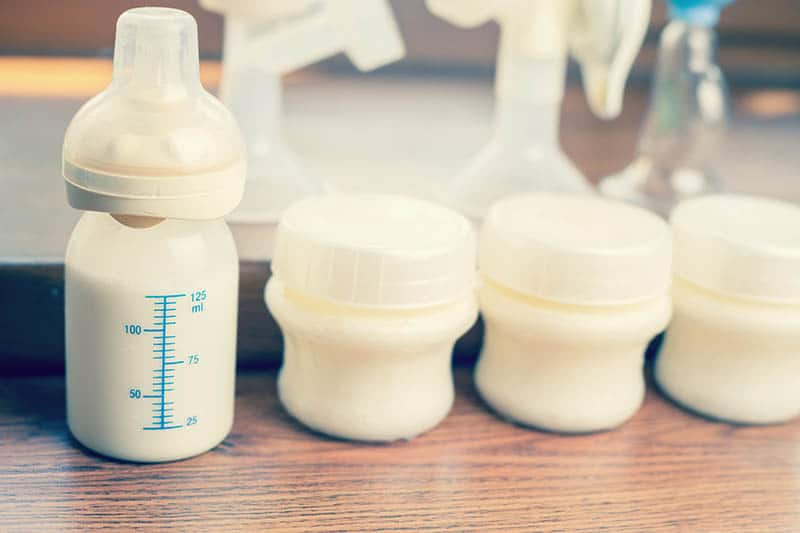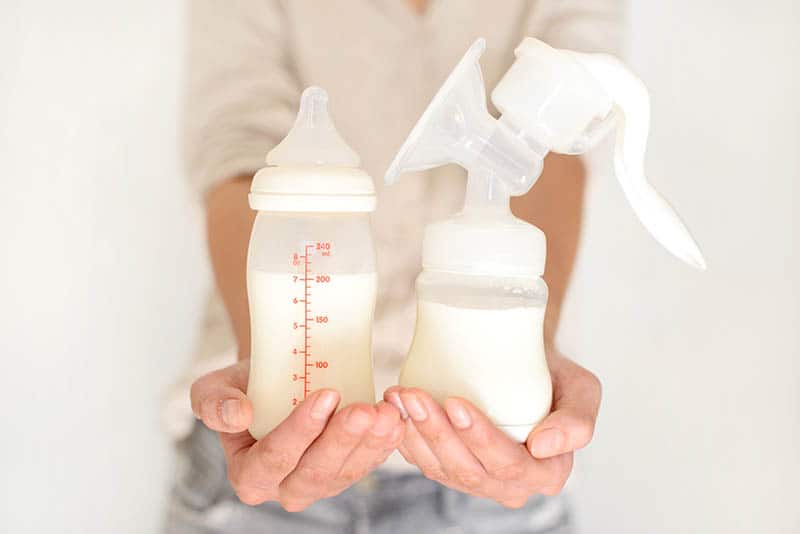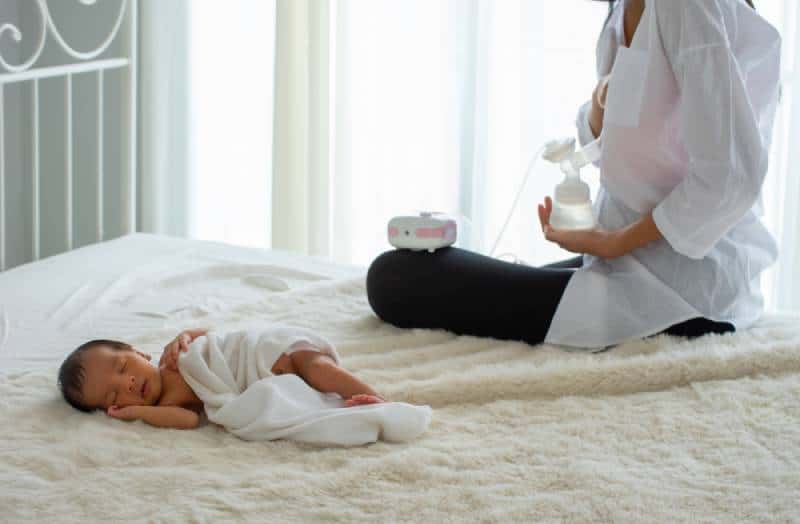Many moms will often ask themselves when to start pumping. When is the right time to start storing milk and getting that surplus of milk ready for the baby?
Is it natural to do it with an electric breast pump? Well, the answer to these questions varies from baby to baby based on a few factors.
If the baby is born early or if there are some other reasons why they can’t start breastfeeding immediately, chances are you might need to start pumping your milk as soon as they’re brought into this world.
This risks early nipple confusion but is ultimately unavoidable if you absolutely have to start bottle feeding them at the start. It’s nothing that can’t be remedied but it can be a bit of a hassle.
Otherwise, the best time to start pumping is usually somewhere within the first few weeks or so, just so you can funnel off any excess milk into bottles for when the baby needs a little extra and your milk flow might not be feeling up to par.
So When Should I Start Pumping?

When asking yourself the question of when to start pumping, it’s not so much about a specific time as it is about your child and you being ready.
Most things to do with babies end up being about personal preference and pumping is no different.
My personal suggestion is setting a pace for yourself and sticking to it.
There is nothing wrong with starting early as long as you can deal with the risk of nipple confusion and a fussier baby during the early stages.
The only thing I’d advise is not to start them too late.
Stick to the aforementioned 4-6 week window to get pumping if you feel the need to and you should do just fine.
How Do I Start In The First Place?

Breast pumping is a great way to encourage milk flow for breastfeeding as well, especially if you use an electric pump.
Simply swapping your pump over to its slow suction setting during your pumping sessions will help stimulate your let down reflex on its own, allowing you to more easily breastfeed your child.
To actually start pumping breast milk, I’d suggest choosing a time of day when you’re the most free and when your partner can tend to your baby’s needs while you work on shoring up your little one’s milk supply.
Start off by finding a nice quiet place for yourself and make it comfortable – maybe put some nice ASMR sounds on or just some relaxing music, brew yourself a cup of tea, or diffuse some aromatic oils.
Whatever helps you be less tense, so that your milk production won’t suffer.
Do a few deep breathing exercises too, just for good measure.
Extra prep never hurts.
Once fully relaxed, try a bit of a breast massage to further reduce tension in the area and help encourage your letdown reflex.
This is a necessary step if you’re using a manual pump since electric breast pumps can do this step all on their own as mentioned earlier, but a bit of extra time to help you get settled always helps.
Some people suggest having your baby with you to make this process easier, but from my experience, it’s just a distraction and that makes the baby cry and disrupt the session more often than it helps, so refrain from having them in the room if you can.
Have your partner keep them occupied instead.
Now that your body is fully relaxed it’s time to attach the breast shields and the flanges properly.
Make sure you get a nice vacuum seal going to prevent any leaks and to make suction as efficient as possible to ensure maximum milk production.
Once everything is in place, it’s time to start pumping. In the case of manual breast pumps, opt for slower pumps and gradually increase the pace later.
Try mimicking how your child suckles, so your breasts can get used to the pace.
If you’re using an electric breast pump, start it off slow using the letdown phase that I mentioned before – the one where the electric pump itself helps massage your breasts with bouts of short, but rapid suction to help kick that letdown reflex in.

After that, you’re free to swap to the expressing phase whenever you see fit.
Pumps usually have timers for when to switch from this letdown phase to the expressing phase.
Experiment when the right time is for you and watch how your baby does it to create a more natural feel and to make you more comfortable with using a breast pump.
The length of your sessions depends on you and on how much milk you need to store, among other factors.
Make sure your pump and the bottles or bags that you use for storing breast milk are kept clean.
Once that’s done, you should now know all of the steps necessary to start breast pumping, manually or otherwise. Simple enough, right?
The only thing left to figure out is how frequent your pumping sessions need to be.
Most moms do it whenever they’re free and that seems to work out the best for them.
For working moms, that goes doubly so since you can’t really align your pumping sessions with your baby’s needs for food when you aren’t pumping if you’re at work (roughly every three hours or so).
Personally, my suggestion is to keep it at your own pace, but if you can manage some sort of schedule in your pumping, then I don’t see a reason why you shouldn’t stick to it as long as it doesn’t interfere with your daily routine too much.
If you’re dealing with engorgement, don’t be afraid to add an extra pumping session to relieve the excess pressure from your breasts.
Start with some hand expressions to make the area around your areola softer and easier to attach the flange to before you begin pumping though.
As for the actual session lengths, that varies from person to person and on how much milk your breasts are capable of expressing.
For most new moms, I’d suggest going for upwards of half an hour or so to make sure you get used to longer bouts of breastfeeding, but also because you’re more likely to have more breast milk stored up in your first pregnancy.
That said, you shouldn’t stick to too much of a strict time schedule, just experiment and find out whether you need less or more time to finish a pumping session.

Don’t forget to keep your pump parts clean, especially the flanges and the breast shields.
If they’re dirty, you not only risk infecting the milk that you produce, you also increase your chances of developing mastitis by allowing bacteria so near to your nipple.
As for the actual act of storage, that one’s simple.
If you’re using matching bottles and breast pumps (e.g. the Spectra or the Medela) you can just stick to using the provided bottles for milk storage.
That’s because the baby bottles are compatible with the pumps for easier bottle feeding and no unnecessary extra containers and steps.
If you do store them, keep them in the freezer if your milk supply is greater than that of other mamas.
That way, you have more time before the milk becomes unusable.
Though if you tend to go through your supply rather quickly, it’s fine to just keep the bottles in the fridge.
Bear in mind that milk lasts a few days in the fridge (3-4) before going bad compared to 6 months if kept in a freezer.
Just leave the milk out to thaw at room temperature and it’ll be good to go.
Always remember to label your milk storage bottles as you’ll want to use the oldest milk first to ensure as little as possible ends up getting spoiled.
Also, always make sure to have enough milk at the ready if you’re a working mom, increasing the number of pumping sessions required if need be.
Should I Use A Manual Or Electric Breast Pump?

Most new moms, alongside the question of when to start pumping, ask themselves whether they should go with a manual pump or an electric one.
People often think a manual one is more natural, but really it’s all up to personal preference and how much you’re willing to invest to keep your hands free.
While manual ones end up being cheaper, they tend to require a lot more effort on your end to pump the same amount of milk that an electric one does and may even take a bit more time depending on your pumping speeds.
Not to mention the wrist issues you might get from such frequent pumping (nothing too severe, just an occasional cramp here and there).
That said, they’re a lot more compact and lightweight compared to electric ones, but personally, I’d still opt for the electric breast pump over the manual one, especially for working moms.
That way you can keep your hands free to do other things while the pump does its thing and helps you clear your breast pumping sessions with minimal effort.
Plus, there are plenty of tote bags around that can help house an electric breast pump, so transportation isn’t an issue.
The one problem they do have though is the fact that not all of them are portable, not everywhere at least.
Some electric breast pumps work off outlets only, so taking it somewhere where you don’t have one readily available is like carrying around an oversized and expensive paper weight.
If you’re going to buy one, get one that has a battery inside so you’re not a slave to the cord and can properly adjust yourself into a pumping position that won’t get you all tangled up.
As for the natural bit,that’s just nonsense – they’re both equally as natural.
Just because something is electric doesn’t mean it won’t provide you with the same benefits as a manual breast pump and the ‘natural’ differences are more or less negligible.
Whatever the case though, do make sure that the pump you get is at least hospital-grade. This usually means that they have stronger suction and are more durable than the pumps that don’t.
Also, make sure that it is a certified hospital-grade device before you buy it as some companies just like to tack that attribute on to sell better.
What Are The Actual Benefits Of Breast Pumping Compared To Just Doing It Naturally?

Again, this is the question I most commonly get asked from the same people who ask about how natural one pump is over the other and that’s completely fine, the more questions you ask, the better informed you are.
That’s arguably the most important part of being a parent.
Now, the benefits of pumping are vast.
For one, you’ll have a lot more time to yourself because now you’ll be able to get a nanny and leave them with an ample supply of stored up breast milk while you and your partner have an outing (or you just have one yourself and leave your partner at home with the baby).
Having extra free time is an invaluable asset in motherhood as it helps you reset and deflate your worries for a bit.
While it is a wonderful period, I’d be lying if I said it wasn’t taxing and prone to being overwhelming at certain times.
You might also want to be a working mom. Pumping helps facilitate that in a similar way that it does for your outings.
If you have enough milk stored up to last you for the day, you’ll be able to manage work while your partner or your nanny takes care of your child while you’re absent.
Sure it will cut into some bonding time with the baby, but you can make that up once you’re back home.
Plus, being at work will also allow for more breast pumping sessions that don’t cut into your free time, since most work environments nowadays have no issues with women pumping in the workplace as long as it’s not too readily apparent.
There’s also a hidden benefit to all of this in the fact that pumping more often keeps your milk supply steadier and allows you to produce more milk more frequently as a result.
It can increase the chance of engorgement, but if you keep to your daily routine, that chance will remain nearly nonexistent.
So if you want to pump more often, feel free to, just make sure to keep to a certain routine and you should be good to go.
How Do I Maintain A High Supply Of Milk When Pumping?

Well, the easy answer to that was mentioned earlier – the more you pump, the more milk you’ll have stored up.
Do keep that in mind if your baby likes to feed more often than normal.
If, however, you’re having trouble maintaining a healthy milk supply despite trying to do it more often, there might be something that’s interfering with it.
If you’re taking any sort of medications, make sure to check if they reduce the levels of milk production in a woman’s body as that’s a common cause of low milk supply.
If they’re absolutely necessary, speak to your doctor about any alternatives that don’t cause such side effects, so you can return to your regular nursing lifestyle without having to worry too much about your milk supply being low.
Other times it may well just be stress as stress is known to interfere with many bodily functions, milk production being one of them.
Try and relax as much as you can during the day, especially during breastfeeding or breast pumping sessions.
Motherhood can be hard, especially in the early stages of being a new mom, due to all of the sudden lifestyle changes.
Balance out the work around the baby with your partner as much as you can and don’t be afraid to call on your friends for a helping hand every once in a while (but don’t abuse that right too much).
This way you’ll be able to share the stress, making it have a greatly diminished effect overall – if any.
Know that mental health care is just as important as physical and you should never neglect it just because it isn’t tangible.
Your baby can sense when you’re tense and will arguably mimic that very behavior, leading to a rather vicious cycle.
If you’re having issues with your milk supply despite all of the above being resolved, speak with your lactation consultant to gain more insight into what else might potentially be causing the problem.
A professional is always the best go-to as far as more in-depth things are concerned and you should never disregard the aid and relief they can bring to you with their advice.
Final Words
I do hope I’ve managed to assist you with yet another frequently asked question by moms everywhere and that it has made your mothering life at least a bit easier.
Until next time.
Like this post? Please share or pin it for later. You can also stay in the loop and follow us on Facebook, Instagram or Pinterest.

This post contains affiliate links. Please see our full disclosure for more info.

